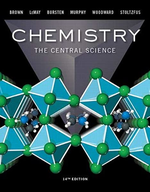?The crystalline hydrate \(\mathrm{Cd}\left(\mathrm{NO}_{3}\right)_{2} \cdot 4
Chapter 19, Problem 19.86(choose chapter or problem)
The crystalline hydrate \(\mathrm{Cd}\left(\mathrm{NO}_{3}\right)_{2} \cdot 4 \mathrm{H}_{2} \mathrm{O}(s)\) loses water when placed in a large, closed, dry vessel at room temperature:
\(\mathrm{Cd}\left(\mathrm{NO}_{3}\right)_{2} \cdot 4 \mathrm{H}_{2} \mathrm{O}(s) \longrightarrow \mathrm{Cd}\left(\mathrm{NO}_{3}\right)_{2}(s)+4 \mathrm{H}_{2} \mathrm{O}(g)\)
This process is spontaneous and \(\Delta H^{\circ}\) is positive at room temperature.
(a) What is the sign of \(\Delta S^{\circ}\) at room temperature?
(b) If the hydrated compound is placed in a large, closed vessel that already contains a large amount of water vapor, does \(\Delta S^{\circ}\) change for this reaction at room temperature?
Text Transcription:
Cd(NO3)2 dot 4H2O(s)
Cd(NO3)2 #4H2O(s) longrightarrow Cd(NO3)2(s) + 4 H2O(g)
Delta H^circ
Delta S^circ
Unfortunately, we don't have that question answered yet. But you can get it answered in just 5 hours by Logging in or Becoming a subscriber.
Becoming a subscriber
Or look for another answer
